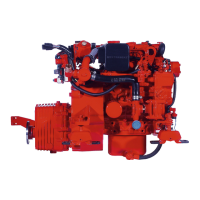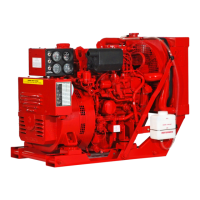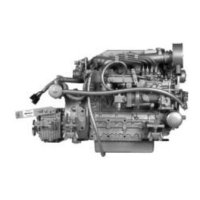STARTING/STOPPING
PROCEDURE
CHECKLIST
Follow
this
check list
each
day
before starting your
engine.
D
Visually
inspect
the
engine
for
fuel,
oil,
or
water
leaks.
D
Check
the
oil
level
(dipstick).
D
Check
the
coolant
level
in
the
coolant
recovery
tank.
Periodically check
the
manifold
coolant
level.
D
Check
the
transmission
fluid
level.
D Check
your
fuel
supply.
D
Look
for clean
fuel
in
the
fuel
filterlwater separator
transparent
bowl.
D Check
for
loose
wires
at
the
alternator
and
make
sure
its
mounting
is
secure.
D Check
the
starting
batteries
(weekly).
D
Check
drive
belts
for
wear
and proper
tension
(weekly).
D Check
the
raw
water
pump
to make sure
its
mounting
is
secure.
STARTING
THE
ENGINE
1. Put
the
transmission in
neutral
and
advance
the
throttle.
2.
Tum
the·
KEY
to
the
ON
position
(2
o'ciock).
(The
panel
is
energized,
gauges
are
lit).
3.
Depress
the
PREHEAT
BUITON, hold
for
5
to
15
seconds
depending
on
how
cold it
is.
(The
fuel lift
pump
is
priming
the
engine
and
the
preheat
is
activated).
4.
Continue
pressing
the
PREHEAT
BUTTON
and
press
the
START
BUTTON.
(The
start motor
is
cranking
the
engine).
5.
Release
the
START
BUTTON
as
the
engine
starts.
6.
With
the
engine
running,
check the instruments for
proper
oil
pressure
and
battery charging
voltage.
Also
check
for overboatd
discharge
of exhaust
water.
The
water
temperature
will
rise
slowly until
the
thermostat
opens.
Do
not
engage
the
gear shift until
the
temperature
is
ciose
to
normal.
NOTE:
Never
attempt
to
engage
the
starter
while
the
engine
is
running.
It
is
important
to
closely
monitor
the
panel
gauges.
become
aware
of
the
normal
engine
readings
and
take
immediate
action
if
these
readings
start
to
vary.
If
a "smart"
regulator
is
part
of
the
charging
system,
allow
about 50
seconds
for
the
RPM
gauge
to.
activate.
NOTE:
When
starting:
A
VQltage
drop
will occur
when
the
preheat·switch
is
depressed.
FAILURE
TO
START
If
the
engine
fails
to
start
when
the
start button is
pressed
for
5
seconds,
wait
for
at least
30
seconds
and repeat
the
starting
procedure.
Make
certain the
transmission
control
is
in
the
neutral
position ..
Never
run
the
starter
motor
for
more
than 30
seconds.
If the
engine fails
to
start.
refer
to
the TROUBLESHOOTING·
CHART
in
this
manual.
A
CAUTION:
Prolonged
cranking
intervals
without
the
engine
starting
can
result
in
the
engine
exhaust
system
filling
with
raw
water.
This
may
happen
because
the
pump
is
pumping
raw
water
through
the
raw
water
cooling
system
during
cranking.
This
raw
water
can
enter
the
engine's
cylinders
by
way
of
the
exhaust
manifold
once
the
exhaust
system
fills.
Prevent
this
from
happening
by
closing
the
raw
water
supply
through-hull
shut-off;
draining
the
exhaust
muffler,
and
correcting.the
cause
of
the
ellcessive
engine
cranking.
Engine
damage
resulting
from
raw
water
entry
is
not
a
warrantable
issue;
the
owner/operator
should
keep
this
in
mind_
STOPPING
PROCEDURES
To
stop
the
engine,
bring
the
throttle
to
an
idle
position and
place the transmission
in
·neutral.
Allow
the
engine
to
idle for
a
few
moments
to stabilize the
engine
temperature.
Then pull
the shut-off teelknob out
and
allow
the engine
to
stop
fully.
Then push
the
shut-off
tee!knob
back in
fully
and
shut-off
with
key.
NOTE:
Units
with
the
Optional
Electric
Shut-Off,
just
turn
off
the
key.
FAILURE
TO
STOP
(Optional
Electric
Shut-Off)
In
the unusual situation that
the
·key
switch
fails
to
tum the
engine off
and
it
stays
at
a
low
idle,
shut down
can
be
accomplished
by
manually
working
the shut off lever located
adjacent
to
the throttle lever
by
the
injection
pump.
NOTE:'
In such,cases the electric fuel
sltut
off soleuoid .
maym,edto be thu:aded into the block an additional
y.
-
V.
turn.
ENGINE
STOP
LEVER'
Engi,.,e$
& Generator$
9

